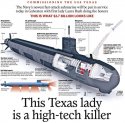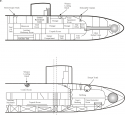Hendrik_2000
Lieutenant General
But you are putting the cart in front of the horse and not the other way around. In order to put in all those anti vibration raft and the associated mechanism and damper, you need much bigger diameter than 10 or 11 m hull. That is design requirement there is no bargaining in it.
Looking at the cross section of the those sub It is cramp as hell there is no way you can fit in those anti vibration raft in 10 or 11 m diameter hull
Whether they design double or single hull it is irrelevant It all depend on the strength of Chinese metallurgy and how advanced they are in producing high strength steel . China design the sub with double hull following Russian practice But I think they can drop that practice now that their steel industry can produced high strength steel
Rail gauge should not be the limiting choice since they can support the carriage with large overhang
Looking at the cross section of the those sub It is cramp as hell there is no way you can fit in those anti vibration raft in 10 or 11 m diameter hull
Whether they design double or single hull it is irrelevant It all depend on the strength of Chinese metallurgy and how advanced they are in producing high strength steel . China design the sub with double hull following Russian practice But I think they can drop that practice now that their steel industry can produced high strength steel
Rail gauge should not be the limiting choice since they can support the carriage with large overhang








